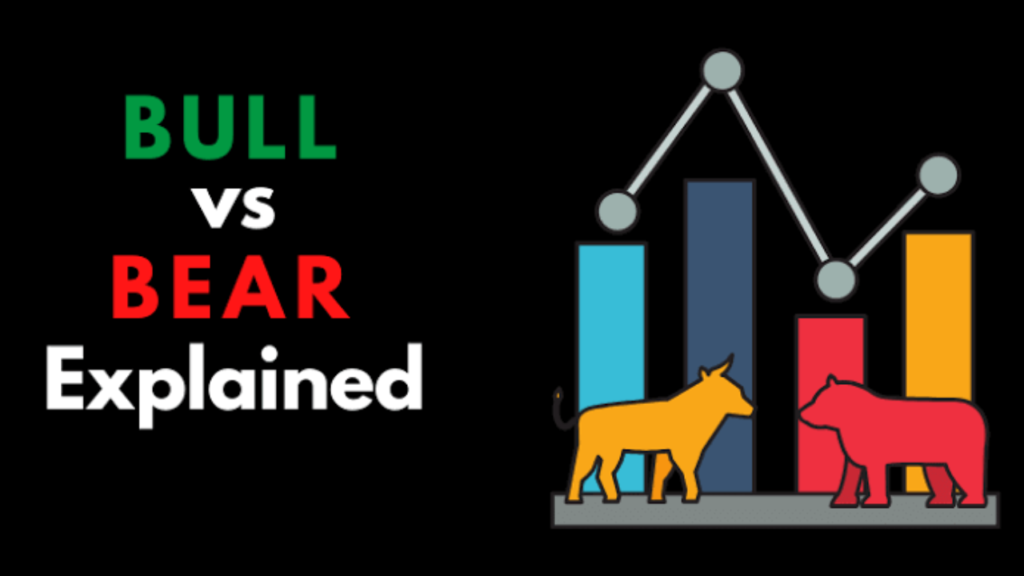In the stock market, the terms “bullish” and “bearish” are used to describe the overall direction of the market or the sentiment of investors.
Bull Market Vs Bear Market
A bullish market, often referred to as a bull market, is a financial market condition characterized by rising asset prices and positive investor sentiment. In a bullish market, investors are optimistic about the future performance of the market and are more inclined to buy securities in anticipation of further price increases. This optimism is typically fueled by strong economic indicators, such as low unemployment, high consumer confidence, and robust corporate earnings. Bull markets are often associated with periods of economic expansion and can last for months or even years, leading to significant gains for investors.
Example: During a bullish market, investors may be optimistic about a particular industry, such as technology, and invest heavily in technology stocks. As more investors buy these stocks, their prices rise, further fueling the bullish sentiment.
Opportunity: In a bullish market, there are opportunities for investors to profit by buying stocks or assets that are expected to increase in value. Investors may also use leverage to amplify their gains, but this also increases the risk of losses if the market turns.
On the other hand, a bearish market, or bear market, is characterized by falling asset prices and pessimism among investors. In a bearish market, investors are concerned about the future performance of the market and may sell off their holdings in anticipation of further declines. This pessimism is often driven by economic downturns, such as recessions, or other negative events that impact market confidence. Bear markets can be short-lived or prolonged, and they can result in significant losses for investors who are not prepared for or able to navigate the challenging market conditions.
Example: In a bearish market, when prices are falling, investors might decide to sell their stocks because they think the prices will keep dropping. This can start a cycle where more people sell, causing prices to fall even more.
Opportunity: In a bearish market, there are opportunities for investors to profit by short selling stocks or assets. Short selling involves borrowing shares and selling them with the hope of buying them back at a lower price in the future. However, short selling carries significant risks, as prices can also rise unexpectedly.
How to invest during Bull and Bear Market
Investing during bull and bear markets requires different strategies due to the contrasting market conditions. In both bull and bear markets, it’s important to have a well-thought-out investment plan that aligns with your financial goals and risk tolerance. Regularly review and adjust your portfolio as needed to stay on track.
Bull Market:
- Buy and Hold: In a bull market, many investors adopt a buy-and-hold strategy, where they purchase investments and hold onto them for the long term, expecting their value to increase.
- Monitor Valuations: While optimism may be high, it’s crucial to monitor the valuations of your investments to ensure they are not overvalued. Overvaluation can lead to a correction when the market sentiment changes.
- Diversification: It’s important to diversify your investments across different asset classes and industries to reduce risk. In a bull market, investors often look for growth opportunities but still aim for a balanced portfolio.
Bear Market:
- Defensive Stocks: In a bear market, investors often turn to defensive stocks, such as those in healthcare, utilities, and consumer staples, which tend to be less affected by economic downturns.
- Value Investing: Consider value investing strategies, where you look for undervalued assets that have the potential to rebound when the market recovers. Focus on diversification and quality investments. Look for companies with strong balance sheets, stable earnings, and a history of dividend payments.
- Stay Informed and Patient: Keep yourself informed about market conditions but avoid making hasty decisions. Bear markets can be volatile, so it’s important to stay patient and not panic-sell.
How to recognize Bull and Bear Market
There is no definite rule or formula to identify a bull or bear market. It involves looking at various indicators and factors can provide clues about the overall direction and sentiment of the market.
Price Movement: Monitor the price movement of the market index like ( Nifty5o, Sensex, S&P 500) over time. In a bullish market, the index will generally show an upward trend, with higher highs and higher lows. In a bearish market, the index will show a downward trend, with lower highs and lower lows.
Technical Indicators: Various technical indicators, such as moving averages, Relative Strength Index (RSI), and MACD (Moving Average Convergence Divergence), can be used to identify bullish and bearish signals. For example, a moving average crossover (where a short-term moving average crosses above a long-term moving average) is often seen as a bullish signal, while the opposite is true for a bearish crossover.
Fundamental Analysis: Fundamental factors, such as economic data, corporate earnings, and geopolitical events, can also influence market direction. Strong economic growth, rising corporate profits, and positive news can support a bullish market, while weak economic data, declining earnings, and negative news can contribute to a bearish market.
It’s important for investors to understand the dynamics of bullish and bearish markets and how they can impact investment decisions. Diversification, risk management, and a long-term investment strategy are key components of navigating both types of markets effectively.

